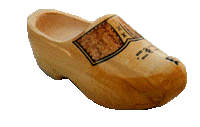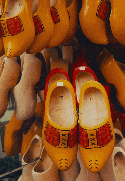 Holland's wooden shoes
Holland's wooden shoes
History
As the Romans had their leather sandals, the Dutchies had their wooden
shoes. For more than 500 years wooden shoes have been made in Holland.
Especially in the east of the country, the making of wooden shoes has been
a tradition for many centuries. First farmers made their own wooden shoes,
which were nothing else but a pair of wooden boards with a little belt
around it. The profession of Woodenshoe-Maker started for the first time in
the Middle Ages. Also in the painting art it had been noticed. The painter
Pieter Breughel the Elder painted wooden shoes for the first time in 1550.
>From the 18th century on, the wooden shoe making had an enormous increase
through the use of machines for the production. From then on, the wooden
shoe had been used everywhere in Holland from the 19th century on and
became an important trade. This ended in the 20th century. Through the
influence of the economical crisis of 1930, (not a direct result of WW I)
the wooden shoe production diminished considerably. Half of the companies
which made wooden shoes, disappeared. After WW II the production increased
again, but not for long. In 1976 only 500 companies were left, of which 150
were automated. The production then amounted to 3 million pairs a year.

For the production, the wood of the poplar is used. The wood is not heavy
and doesn't smell, it is very tough, but easy to work with. The tree grows
fast and after 20-25 years it can be cut down. It is sawed to blocks, which
are made into shoes. The painting and decorating of the wooden shoes is
done by hand, but one can have unpainted shoes as well.
Wooden shoes which are used on work days, were mostly unpainted. These were
scoured with sand at the end of the week. Only on Sundays, decorated ones
were worn. The decorations varied in the different parts of Holland.
Wooden shoes are very warm, which was very welcome in terrible winters.
When it was extra cold, the wooden shoes were filled with hay.





